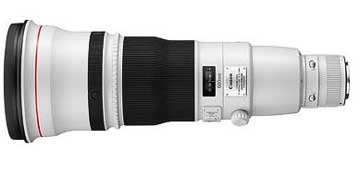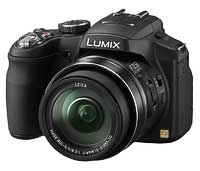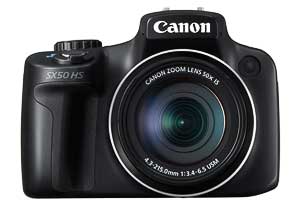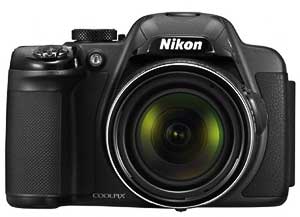Top Three Superzoom Cameras
recommended for Wildlife Pictures
I recently received an email asking for camera advice. Here's the gist of it:
"I have photographed black bears for 35 years. My beloved and ancient camera has died. I have to venture into the world of digital cameras and it is
scary!
"My price range is around $600.00. I will be in the back country for the month of October 2013. I have to travel light. I do not require extra lenses.
Great filters, fairly quite shutters, and a flash are a must. I am not a brand snob."
And here's the essence of my reply:
From what you've told me, the immediate options would be a digital SLR with a couple of lenses, or a compact superzoom.
But you don't want to carry extra lenses, so we can eliminate an SLR and look at the superzoom options.
The best ones are fairly bulky and look and weigh almost as much as a basic SLR - but that's it, no additional lenses required,
which should satisfy the "traveling light" requirement.
While I know nothing about black bears, I do understand that wild animals are unpredictable and often dangerous, so assume you'll want
to respect their space and not get too close - which means you'll need a longish telephoto lens.
From my experience photographing wildlife, it's usually better to have more reach than too little. The current crop of superzooms have mind-boggling lenses, with some going over 1000mm equivalent when fully zoomed.
To keep this fairly simple, I'll keep my recommendations to three cameras:
- Panasonic Lumix DMC-FZ200
- Canon PowerShot SX50 HS
- Nikon Coolpix P510/520
Panasonic Lumix DMC-FZ200
The Panasonic is the most expensive (about $585) but is unique in that its Leica lens has a maximum aperture of f/2.8 throughout the
zoom range. It's a 24x zoom, giving the 35mm equivalent of 25mm (wide angle) to 600mm (telephoto).
So you have a light, hand-holdable camera that allows you to shoot with your aperture wide open at f/2.8 even when the lens is fully zoomed to 600mm.
That's pretty amazing, a 600mm f/2.8 lens!
There's nothing to match that amongst the hugely expensive pro lenses. Canon's 600mm lens has a maximum aperture of f/4
while the Canon EF 400mm f/2.8 weighs 8.5 lb and will set you back around $11,500.

Canon 600mm f/4, weighs 9 lb, costs $13,000

Lumix FZ200, 1.29 lb, $590
Why is this wide maximum aperture so important?
Mainly because it allows use of higher shutter speeds (to freeze subject movement
and minimise camera shake) when shooting in low light. With modern DSLR cameras, you can get round this limitation to some extent by pushing up your ISO to 1600 or more.
But that's not the case with compact cameras. They're fitted with tiny sensors that can't cope with high ISOs, producing very "noisy" or
grainy images once you go above 800 ISO, so you want to keep your ISO to 400 or less.
Take this scenario as an example: it's early morning, the light is lovely and soft, but not very bright. You need a shutter speed of at
least 1/250 or faster to freeze subject movement and eliminate camera shake when the lens is fully zoomed to 600mm. With ISO at 400 and
aperture at f/2.8, you can still shoot at 1/250 sec, which should be enough with the camera's image-stabilized lens.
But if your maximum aperture at 600mm is f/5.6 (two-stop difference), your shutter speed drops to 1/60. To get back to 1/250, you need to
push up your ISO from 400 to 1600. Unfortunately, on compact cameras 1600 ISO will produce too much noise. The image will be usable on the Web or
printed at 5" x 7", but really for not much else, unless it's for research or possibly art reference.
Another advantage of that nice, wide f/2.8 aperture is its limited depth-of-field, which will give you soft, out-of-focus backgrounds. This is important for wildlife photography,
reducing background clutter and making your subject stand out more clearly.
So for me, this lens is the clincher, making the FZ200 my first choice.
This camera also has a hot-shoe and can take a wide range of accessories, including filters, lens add-ons, and dedicated flashes. Of importance to
the more serious photographer, it can also shoot in RAW, giving you greater control when editing your images.
For additional information and buyers' opinions, see:
U.S. Customer reviews for the Panasonic FZ200 from Amazon.com from Amazon.com
Canon PowerShot SX50 HS

Canon PowerShot SX50 HS Superzoom
The Canon SX50 is also unique in that it has an amazing 50x zoom lens, which is equivalent to a 24mm to 1200mm lens on a traditional 35mm film camera.
However, unless you photograph a lot of birds or want real close-ups of your bears, you're not often going to need 1200mm.
The Canon certainly has a lot going for it; however, maximum aperture changes as you increase the zoom, reducing your options in lower light.
At wide angle (24mm), the max is f/3.5, changing to a slow f/6.3 at full zoom. At 600mm, maxium aperture is f/5.6, so two stops slower than the
Panasonic at equivalent focal length.
This means is that you'lll need to push up your ISO to 800 or more in low light if you need a reasonably fast shutter speed. If you'll be
using the Canon most the time in bright light, the smaller maximum aperture is not an issue and you have the benefit of that 1200mm lens.
Unlike its predecessor, the SX40, the SX50 can shoot in RAW, which is an advantage when editing or post-processing noisy images shot at high ISO.
The Powershot SX50 (current price around $450) is my second choice and could possibly top the list if I was going to use it primarily in bright light,
or shoot static subjects, like perching birds, using a tripod or similar support.
I have to admit that massive 1200mm focal length is mighty appealing!
For additional information and opinions of people who've used the camera, see:
U.S.Customer reviews of the PowerShot SX50 HS from Amazon.com from Amazon.com
Nikon Coolpix P520
The Nikon Coolpix P520 is brand new, announced earlier this year. It replaces the Coolpix P510, although there doesn't appear a great deal of difference between the two.

Nikon Coolpix P520
The P520 has a 42x zoom lens, giving you the equivalent of a 24mm to 1000mm lens on a 35mm camera, which is unchanged from the P510.
Nikon have, however, pushed up the megapixels from 16 to 18MP on the new model. This is a lot more than the Panasonic and Canon, both of
which are fitted with 12MP sensors.
In my view 12MP is more than adequate and, generally, the more megapixels you cram on to a tiny sensor, the greater the noise problems at higher ISOs.
In any event, the P510 has proved to be a very capable camera and the P520 should be at least as good. In addition to the extra megapixels, the P520 now has a
built-in GPS. Unfortunately, unlike its competitors above, the P520 is not able to shoot in RAW. This won't bother most users, but for optimum results, the ability to post-process in RAW
is a definite bonus.
The maximum aperture of both the P510 and P520 is f/3 at wide angle (24mm) and f/5.9 at telephoto (1000mm), offering great versatility, especially in good light.
Howerver, the Coolpix has to be my third choice, mainly because it doesn't offer RAW shooting and also doesn't have a hot-shoe for external flash.
For additional information and opinions of users, see:
U.S. Customer reviews of the Coolpix P520 from Amazon.com from Amazon.com
HD Video
All three cameras can shoot HD video and have effective image-stabilization, but I'm not going to discuss video in detail here. You can see examples of their video capability in our
selection of video reviews.
There are other worthy contenders - from Sony, Fuji, and Olympus - in the superzoom category, but often too many choices only cloud the
issue further, so I've not included them.
One final suggestion: if possible, go into a camera store and handle your shortlist of cameras before making a final choice. Sometimes one camera will just feel better than another,
with the buttons and knobs more easily accessible, the viewfinder clearer, the weight just right.
At the end of the day, these top-of-range superzoom cameras from reputable manufactures are all pretty similar, like today's top-brand cars, so maybe the one
that feels best is the correct choice.
See also Choosing a Camera for Wildlife - the Superzoom Option for an overview of using a superzoom for wildlife photography.
Return to Photo Info page for more photography articles.
|




